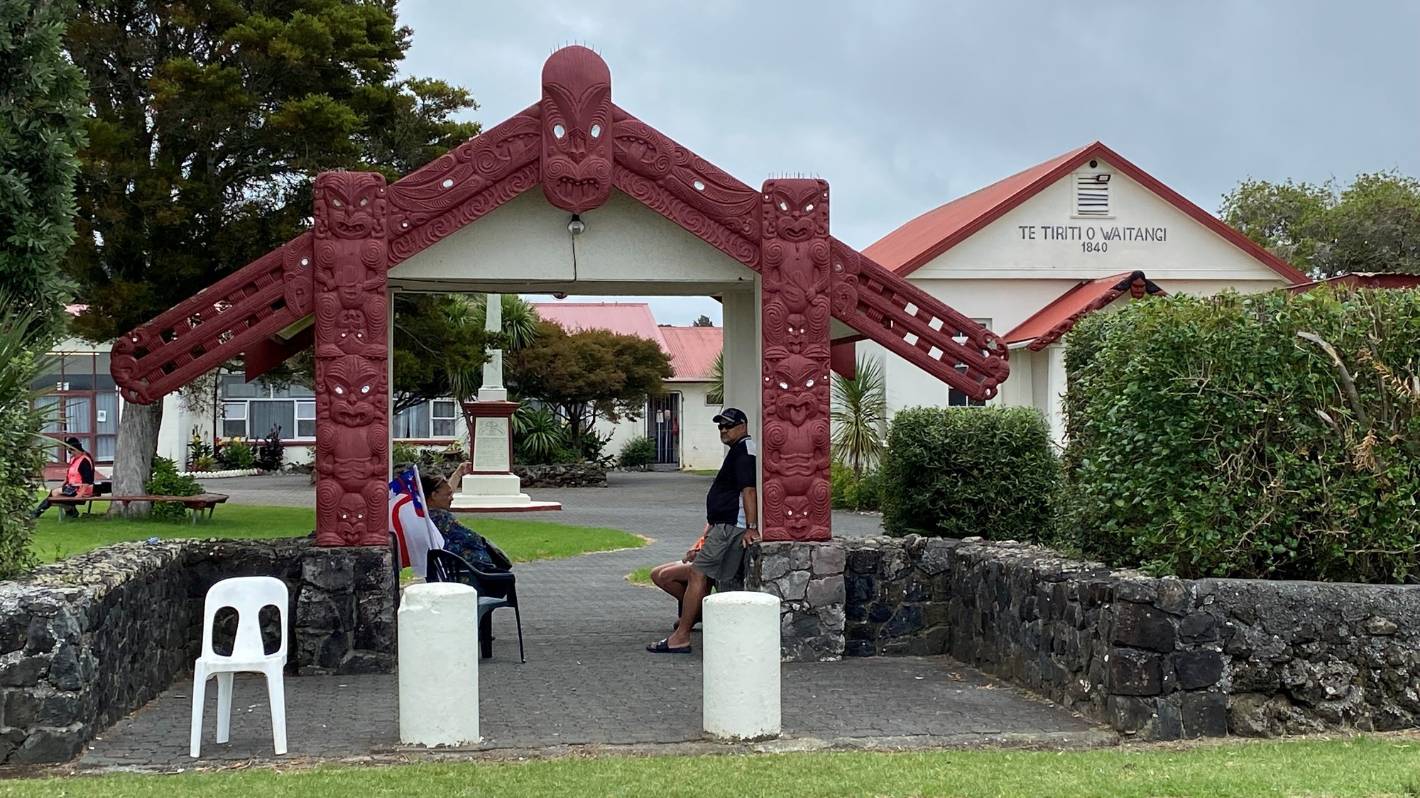For more than 90 years, people have referred to the Waitangi Treaty Grounds as the upper marae. It is not. Confusion over what constitutes a marae has Te Tii Marae wrongly referred to as the lower marae – it is the only marae. Pou Tiaki explores what makes a marae and how this enduring mistake came to be.
Read this story in te reo Māori and English here. / Pānuitia tēnei i te reo Māori me te reo Pākehā ki konei.
So what constitutes a marae?
Essentially, a marae is a complex of buildings and grounds that belong to a particular iwi (tribe), hapū (subtribe) and whānau (family).
A marae consists of a wharenui (meeting house, which may also be called a whare tīpuna, ancestral house, or wharepuni), a marae ātea (open area in front of the wharenui), wharekai (kitchen and dining hall) and wharepaku (toilet and shower block).
READ MORE:
* Waitangi on Sunday: Quietness is ‘surreal’, time for honest reflection
* Waitangi Day in red: Events and activities across Aotearoa
* Waitangi Treaty Grounds: Why they’re the birthplace of our nation
* Editorial: Some may protest, but today’s a family day
Marae are used for celebrations, tangihanga (funerals), hui, wānanga and other important events.
Te Tii Marae
Te Tii Marae is the only marae at Waitangi, says marae chairman Ngāti Kawa Taituha.
Often wrongly referred to as the “lower marae”, it is located to the north of Paihia, next to the Waitangi River mouth in the Bay of Islands.
Denise Piper/Stuff
It was a quiet day at Te Tii Marae on Waitangi Day 2022 with the pandemic forcing cancellation of commemorations.
“Ngāti Rāhiri and Ngāti Kawa are the mana whenua of all of Waitangi, including at the Treaty Grounds,” Taituha says.
Te Tii Marae is linked to the inland mountain pā of Pouerua, and claims descent from the waka Ngātokimatawhaorua.
Waitangi Treaty officials/Supplied
The black box is Waitangi Treaty Grounds, situated within the red box of the Waitangi National Trust Estate – though the estate is more extensive and runs through to Haruru Falls. The red box is not indicative of the true size of the estate. The green box is the other half of Waitangi, the community in which Te Tii Marae is located on Te Karuwha Parade. (Map supplied by Waitangi curator Caitlin Timmer-Arends)
“It is the only tribal centre in Waitangi where all of our hapū events happen frequently. It provides us all with spiritual sustenance,” Taituha said. “We call it home.”
Waitangi Treaty Grounds
Te Whare Rūnanga, the wharenui on the Waitangi Treaty Grounds, has no ancestral link to a particular hapū or iwi, however, the land on which the wharenui stands does. The whenua is called Ruarangi, its original place name.
The wharenui was built in 1940 to mark the centenary of Te Tiriti and represents all iwi across Aotearoa, Waitangi curator and guide manager Caitlin Timmer-Arends says.
David Kirkland
Te Whare Rūnanga was opened on February 6,1940, and stands facing the Treaty House on the upper grounds at Waitangi.
“Te Whare Rūnanga was never intended to be a marae. It was always a whare rūnanga. However, insofar as having a marae ātea in front of it, it can act to fulfil some of the functions of a marae such as pōwhiri,” Timmer-Arends said.
“The Māori house [Te Whare Rūnanga] was deliberately placed in an unusual southern position to face the British house as if they were talking to one another, keeping the conversation about the Treaty alive,” Taituha said.
Te Puna MÄtauranga o Aotearoa
Lord Charles Bledisloe being presented with a painting at Waitangi in 1934.
Māori MPs Sir Apirana Ngata and Tau Henare developed the design concept and led the project.
Te Whare Rūnanga was built to represent all tribes of the Māori Nation. The feeling at the time was that if Maori did not survive the population collapse and became an extinct race then the carved house would be the Māori gift to the world in which every race could remember them.
It is an exquisite example of Māori arts and crafts, Taituha said.
What has caused the confusion?
“The perception of Waitangi being only the Treaty Grounds is what’s tripping many people, including the media,” Timmer-Arends said.
“The precinct of Waitangi encompasses the Waitangi National Trust Estate of which the Treaty Grounds is part. It is administered by the trust board, established in 1932 when the Deed of Trust was drawn up following the purchase of the land by Bledisloe.
“Across the bridge from the estate is the other half of Waitangi, where the marae is, as well as a whole community including houses, businesses, etc,” Timmer-Arends said.
Taituha said Ngata and Henare placed Te Whare Rūnanga at the Treaty Grounds in 1940 for a very different purpose.
“Not as a fully functional marae but more as a cultural arts display to represent all Māori of Aotearoa.”
Waitangi Treaty officials/Supplied
A close-up of the black box of Waitangi Treaty Grounds, with the Upper and Lower Treaty Grounds identified. Te Whare Rūnanga is located on the upper grounds (orange box). (Map supplied by Waitangi curator Caitlin Timmer-Arends)
Timmer-Arends said confusion between the “upper marae” and “lower marae” has a lot to do with the hill.
“Te Tii sits at sea level and to go to Te Whare Rūnanga requires walking up a hill. When Treaty Grounds staff talk about Upper and Lower, it is always in reference to the identified areas above – never to the marae which is its own entity,” she said.
“For a very long time, Te Tii Marae has been unfairly identified by the media as the lower marae when it is the only marae.”
How should we refer to it then?
Te Tii Marae and the Waitangi Treaty Grounds and when referring to the wharenui on the Treaty Grounds, it is Te Whare Rūnanga.



